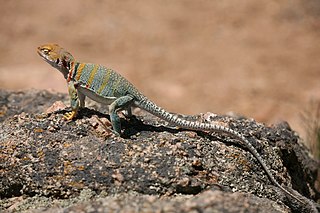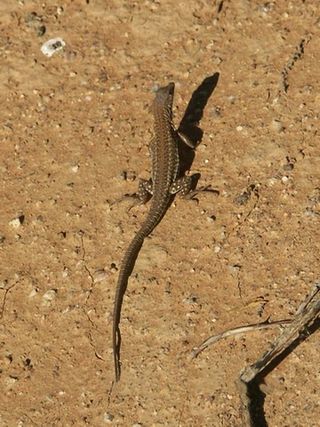
Golden moles are small insectivorous burrowing mammals endemic to Sub-Saharan Africa. They comprise the family Chrysochloridae and as such they are taxonomically distinct from the true moles, family Talpidae, and other mole-like families, all of which, to various degrees, they resemble as a result of evolutionary convergence. There are 21 species. Some are relatively common, whereas others are rare and endangered.

The Crotaphytidae, or collared lizards, are a family of desert-dwelling reptiles native to the Southwestern United States and northern Mexico. Alternatively they are recognized as a subfamily, Crotaphytinae, within the clade Pleurodonta. They are very fast-moving animals, with long limbs and tails; some species are capable of achieving bipedal running at top speed. This species is carnivorous, feeding mainly on insects and smaller lizards. The two genera contain 12 species.

The Phrynosomatidae are a diverse family of lizards, sometimes classified as a subfamily (Phrynosomatinae), found from Panama to the extreme south of Canada. Many members of the group are adapted to life in hot, sandy deserts, although the spiny lizards prefer rocky deserts or even relatively moist forest edges, and the short-horned lizard lives in prairie or sagebrush environments. The group includes both egg-laying and viviparous species, with the latter being more common in species living at high elevations.

Ptenopus is a small genus of lizards, known commonly as barking geckos, in the family Gekkonidae. The genus is endemic to southern Africa. There are only three described species in this genus.

The zebra-tailed lizard is a species of lizard in the family Phrynosomatidae. The species is native to the Southwestern United States and adjacent northwestern Mexico. There are nine recognized subspecies.

The greater earless lizard is the only species in the monotypic genus Cophosaurus. It is closely related to the smaller, lesser earless lizards and other species in the genus Holbrookia, and in fact was placed in that genus and referred to Holbrookia texana from 1852 into the 1970s. Earless lizards lack external ear openings, an adaptation to burrowing in the sand, as are the recessed lower jaw and flared upper labial scales. Greater earless lizards are sexually dimorphic, males grow larger and are more colorful than females, exhibiting pink and green colors that are particularly bright in the breeding season. Two bold black bars mark the lateral region of males but are greatly reduced and vague, or occasionally entirely absent in females.

Meroles is a genus of lizards, commonly known as desert lizards, in the family Lacertidae. The genus contains eight species, inhabiting southwestern Africa, especially the Namib Desert.

The Coachella Valley fringe-toed lizard is a species of phrynosomatid lizard.

The Indian fringe-fingered lizard, also known commonly as the Indian fringe-toed lizard, is a species of lizard in the family Lacertidae. The species is endemic to Asia.

The Mojave fringe-toed lizard is a species of medium-sized, white or grayish, black-spotted diurnal lizard in the family Phrynosomatidae. It is adapted to arid climates and is most commonly found in sand dunes within the Mojave Desert. Fringe-toed lizards are characterized by their fringed scales on their hind toes which make locomotion in loose sand possible.

A xerocole, is a general term referring to any animal that is adapted to live in a desert. The main challenges xerocoles must overcome are lack of water and excessive heat. To conserve water they avoid evaporation and concentrate excretions. Some are so adept at conserving water or obtaining it from food that they do not need to drink at all. To escape the desert heat, xerocoles tend to be either nocturnal or crepuscular.

Ichnotropis capensis is a species of African lizard, which is native to the southern Afrotropics. It is the type species for the genus Ichnotropis, and is commonly called the Cape rough-scaled lizard due to them being found in southern Africa's Cape region. They are also called ornate rough-scaled lizard or Smith's rough-scaled sand lizard. The small lizards are terrestrial and occur in grassland, desert and brush areas of southern Africa.

Duméril's fringe-fingered lizard is a species of lizard in the family Lacertidae. A. dumerilii is in the A. scutellatus species group. A. dumerilii is native to the western and central Sahara.

Teratoscincus scincus, commonly referred to as the common wonder gecko or the frog-eyed gecko, is a species of lizard in the family Sphaerodactylidae. The species is native to arid parts of Asia and has special adaptations which suit it to desert life.

The desert egernia, unadorned desert-skink or desert skink is a species of skink, a lizard in the family Scincidae. The desert egernia is endemic to the continent of Australia, and is widespread, with populations recorded in all mainland states and territories except the Australian Capital Territory. The desert egernia is found in dry, desert areas with deep, uncompacted sandy/loamy soils and little significant vegetation cover.

The broad-banded sand-swimmer or Richardson's skink is a species of skink found in Australia.
The yellow-tailed plain slider is a species of skink located primarily in the desert areas of South Australia, Western Australia, Northern Territory and New South Wales in Australia. This uncommon lizard can be identified by its bright yellow tail, and is usually found buried under loose soil, tree stumps and leaf litter.

The Colorado Desert fringe-toed lizard is a species of medium-sized, diurnal lizard in the family Phrynosomatidae. It is adapted to arid climates and is most commonly found in sand dunes within the Colorado Desert of the United States and Mexico.

The Mohawk Dunes fringe-toed lizard is a species of phrynosomatid lizard endemic to the U.S. state of Arizona. Its name is a reference to American actress Uma Thurman, as both a pun on the genus name Uma as well as a tribute to the actress for her conservation advocacy.

The Yuman Desert fringe-toed lizard is a species of phrynosomatid lizard endemic to northwestern Mexico, although a hybrid population of it and Uma notata ranges north to southwestern Arizona in the United States.























